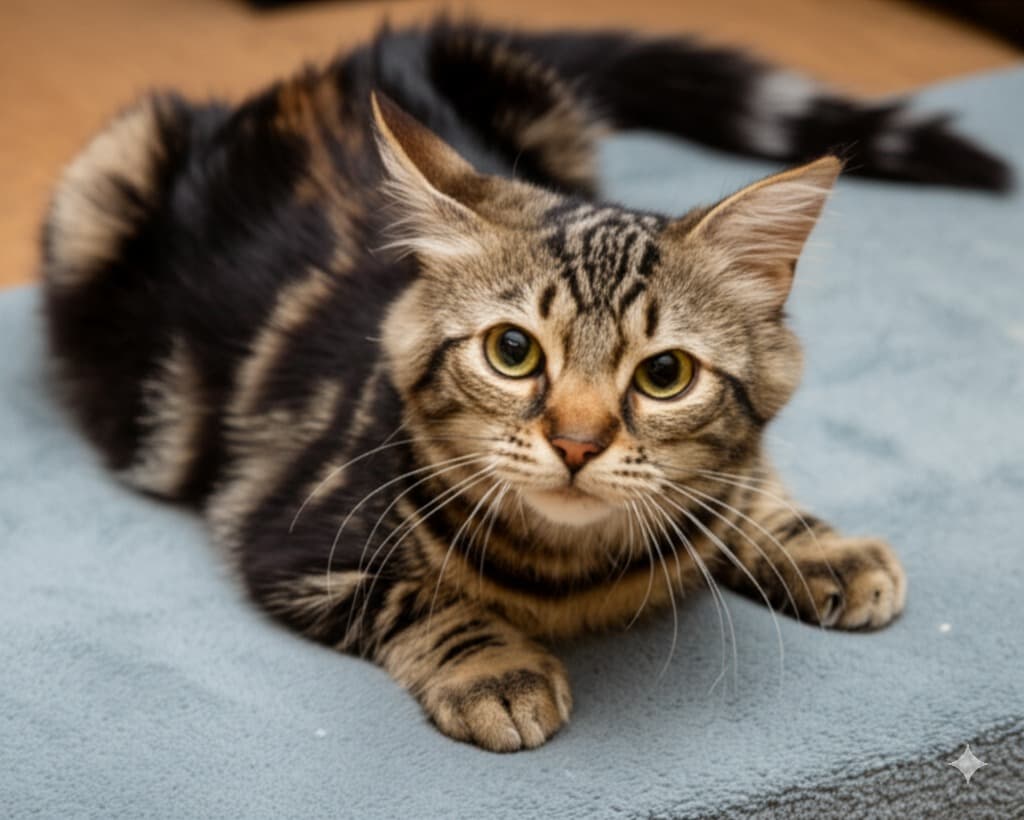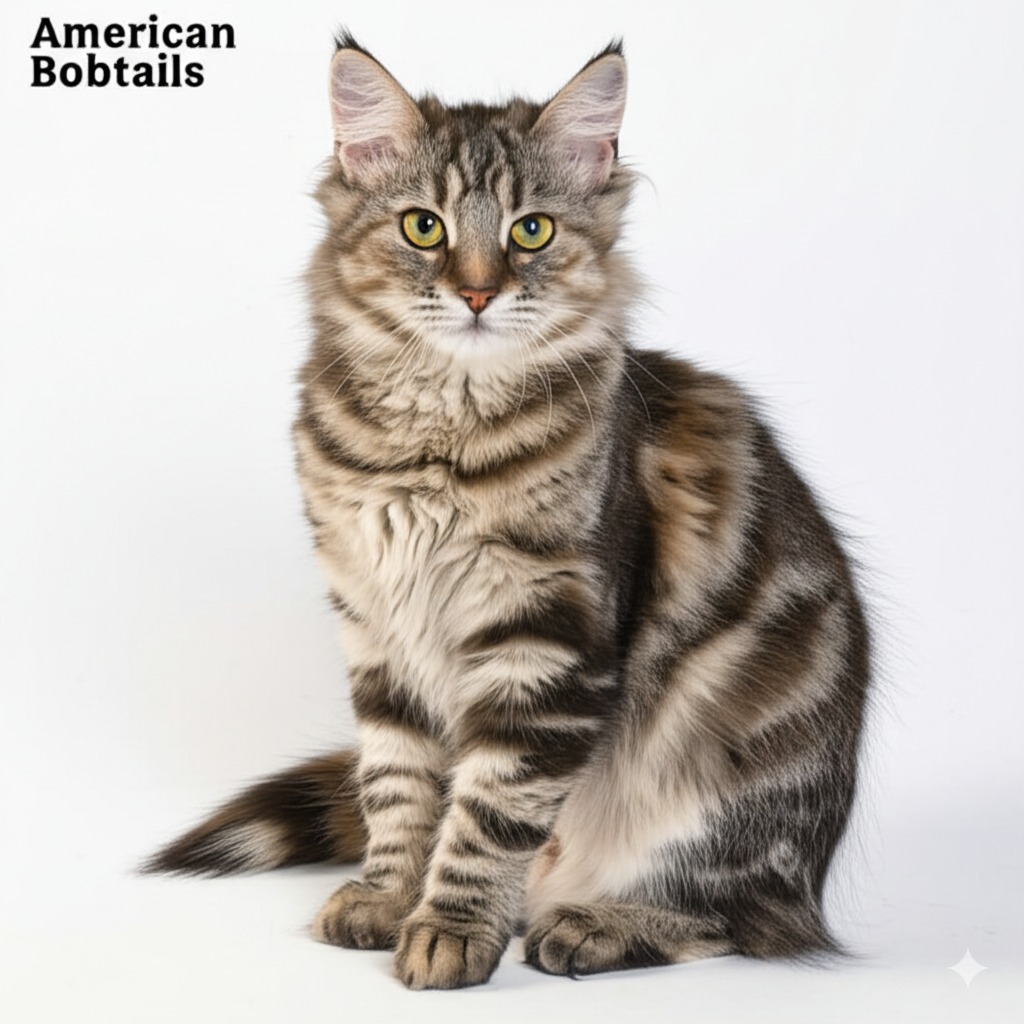Important Disclaimer:
The information provided on this page about the American Bobtail cat breed is intended for general knowledge and informational purposes only and does not constitute professional veterinary advice. Always consult with a qualified veterinarian for any health concerns or medical conditions related to your cat. The breed identification provided by our AI tool is a prediction and should not be considered a definitive diagnosis.
American Bobtail Breed Overview: Unveiling the Bobtailed Beauty
Breed Name | American Bobtail |
Origin | United States |
Personality | IntelligentPlayfulDevotedAdaptableInteractive |
Best For | Families with ChildrenIndividuals Seeking CompanionshipHomes with Other Pets (with proper introduction)Truck Drivers (known for adaptability) |
Grooming Needs | Moderate – Weekly Brushing (more for longhair) |
Common Health Issues | Generally Healthy BreedHypertrophic Cardiomyopathy (HCM) - like many breedsHip DysplasiaPotential spinal issues (rare with responsible breeding) |
Size & Weight | Medium to Large (Males: 12-16 lbs, Females: 7-11 lbs) American Bobtails are muscular and athletic with a rectangular stance. |
Life Span | 13-15 years |
American Bobtail History and Origin: A Naturally Bobbed Tail
Did you know?

American Bobtail cat relaxing in a comfortable home environment

Early examples of American Bobtail cats showcasing the natural bobtail
American Bobtail Key Physical Features & Identification: Spotting a Bobtail
How to Recognize a American Bobtail Cat Breed?
The most distinguishing feature of the American Bobtail is its naturally occurring short tail, typically one-third to one-half the length of a normal cat tail. They are medium to large cats with a noticeably athletic and muscular build, giving them a somewhat rugged appearance.
Their most distinctive physical features include:
- Distinctive bobbed tail (1-4 inches), which can be straight, slightly curved, or have bumps.
- Muscular, substantial body with a rectangular stance.
- Broad head with a slightly rounded brow, medium-length muzzle.
- Eyes are almond-shaped and expressive; color doesn't necessarily correspond to coat color.
- Ears are medium-sized, wide-set, and may have tufts (lynx tips).
- Coat can be short or medium-long, dense, and resilient to weather. All colors and patterns are accepted.
- Hind legs are slightly longer than front legs, with large, round paws that may have toe tufts.

An American Bobtail cat showing its characteristic short tail and muscular build
Common Coat Colors & Patterns
The American Bobtail is accepted in any genetically possible color and pattern, both in shorthair and medium-longhair varieties. Their 'wild' look is part of the appeal.
American Bobtail Personality & Behavior: The Golden Retriever of Cats?
Energy Level
Playfulness
Intelligence
Affection Level
Vocalization
Fun Fact
American Bobtail Diet & Nutrition Guide: Fueling Your Devoted Companion
Best Food Types for American Bobtails
Foods to Avoid
Some foods are toxic to cats and should never be given:
- Foods with excessive fillers like corn, wheat, and soy
- Low-quality foods lacking sufficient animal protein
- Human foods toxic to cats (onions, garlic, chocolate, grapes, etc.)
- Raw diets require careful planning and veterinary consultation due to health risks.
Recommended Products
High-Quality Commercial Dry Food
Formulated for adult cats or specific life stages.Protein-Rich Wet Food
Adds moisture and variety to their diet.
Feeding Tips
- Follow feeding guidelines on the food packaging, adjusting for your cat's weight and activity.
- Provide access to fresh, clean water at all times.
- Monitor their weight to prevent obesity, which can strain joints.
- Consider puzzle feeders to provide mental stimulation during mealtime.
American Bobtail Breed Health & Common Issues: Keeping Your Bobtail Fit
Important Disclaimer:
| Issue | Symptoms | Prevention |
|---|---|---|
| Hypertrophic Cardiomyopathy (HCM) | Heart murmur, rapid breathing, lethargy. Screened for by responsible breeders via echocardiogram. | Choose breeders who screen their breeding cats. |
| Hip Dysplasia | Lameness, difficulty jumping, arthritis later in life. | Maintain healthy weight, select cats from screened lines. |
| Spinal Issues related to the Bobtail (Manx Syndrome - rare in Bobtails) | Issues with defecation/urination, hind leg weakness (very rare in Bobtails compared to Manx). | Reputable breeders avoid breeding cats with extremely short or problematic tails. |
| Polycystic Kidney Disease (PKD) | Increased thirst/urination, weight loss, kidney failure (if foundation cats included Persians). | Genetic testing available for breeders. |
Preventive Care
- Regular veterinary check-ups (annual or semi-annual).
- Keep vaccinations current.
- Year-round parasite prevention (fleas, ticks, worms).
- Choose a kitten from a reputable breeder who performs health screenings.
When to See a Vet?
- Discuss any signs of limping or difficulty moving.
- Report changes in appetite, thirst, urination, or defecation.
- Mention any episodes of lethargy or breathing issues.
- Schedule regular dental check-ups and cleanings as recommended.
American Bobtail Grooming and Maintenance: Caring for Their Coat and Tail
Brushing Needs for American Bobtails
Other Grooming Needs
Brushing Needs
Shedding Level
Recommended Grooming Products
Slicker Brush or Metal Comb
Effective for both coat lengths.Cat Nail Clippers
For regular nail maintenance.Pet Toothbrush and Toothpaste
For at-home dental care.
Is an American Bobtail Right for You? Considering an Adaptable Friend
Perfect For:
Families with children and other pets (with proper introductions).
Their patient and playful nature makes them great family companions.Individuals or couples seeking an interactive and devoted cat.
They thrive on companionship and enjoy being part of the household.First-time cat owners looking for an adaptable breed.
Their easygoing nature can make them a good choice for novices.People who travel (e.g., RVers, truckers) and want a feline companion.
They are known for adjusting well to changing environments.
Not Ideal If:
Someone wanting an extremely independent, aloof cat.
Bobtails crave interaction and connection with their humans.Homes where the cat will be consistently left alone for very long hours without enrichment.
While adaptable, they need companionship and mental stimulation.Individuals seeking a very low-shedding or hypoallergenic breed.
They have a dense coat and shed moderately.
American Bobtail Temperament and Activity Level: A Confident Explorer
Interaction with Strangers
American Bobtails are typically confident and friendly, often greeting guests at the door. Early socialization helps ensure they are comfortable and outgoing with new people.
Activity Level Throughout Life
They have a moderate activity level. They enjoy bursts of play and exploration but are also happy to relax near their humans. Provide opportunities for climbing and interactive play daily.
Trainability
Their intelligence makes them highly trainable. They respond well to positive reinforcement and enjoy learning:
- Fetch
- Leash walking
- Basic commands (sit, come)
- Puzzle toys and clicker training
Keep training sessions short, fun, and rewarding to maintain their interest.
American Bobtail Living Requirements: Creating a Happy Bobtail Home
Space Requirements
American Bobtails are adaptable and can thrive in apartments as well as larger homes, provided their needs for exercise and mental stimulation are met. Access to vertical space like cat trees is beneficial.
Environmental Enrichment
Enrichment is key to keeping an intelligent Bobtail happy:
- Sturdy Cat Trees and Shelves: For climbing, perching, and surveying their domain.
- Interactive Puzzle Toys: To challenge their clever minds.
- Variety of Toys: Including wand toys, balls, and catnip mice.
- Scratching Posts: Offer vertical and horizontal options.
- Window Perches: For bird watching and observing the outdoors.
Dealing with Shedding
Moderate shedding can be managed with regular grooming:
- Brush weekly (shorthair) or 2-3 times weekly (longhair).: Removes loose fur and prevents matting.
- Consider a deshedding tool during peak seasons.: Use carefully to avoid irritating the skin.
Introducing to Other Pets
Bobtails generally coexist well with other cats and cat-friendly dogs when introduced properly:
- Gradual introductions.: Start with scent swapping and visual contact through a barrier.
- Supervised interactions.: Keep initial meetings short and positive.
- Provide separate resources.: Ensure each pet feels secure with their own space and bowls.
While generally good-natured, always supervise interactions, especially initially. Their prey drive is typically moderate.
